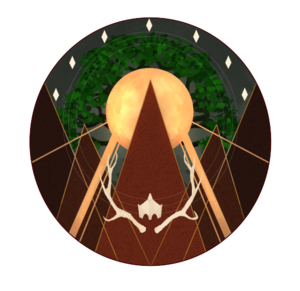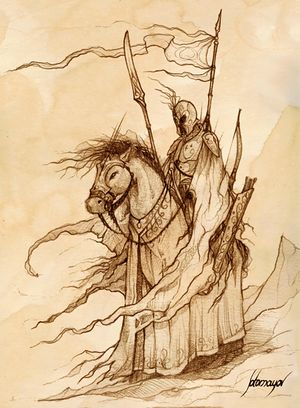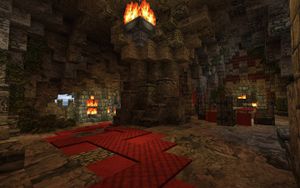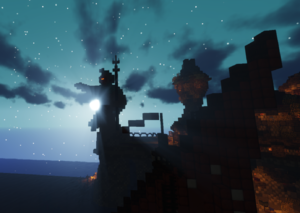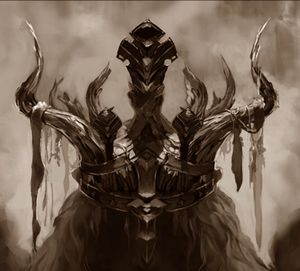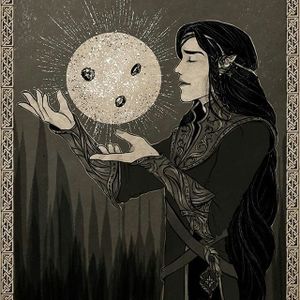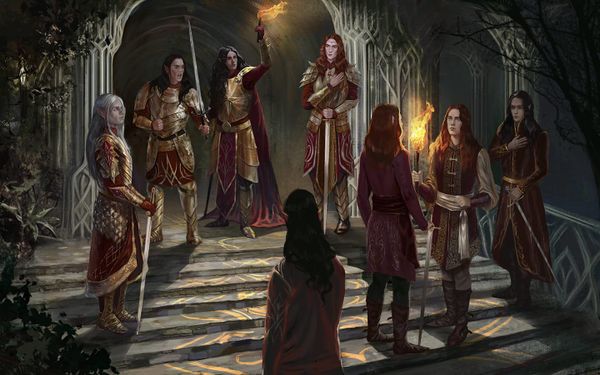Aegrothond
| |||||||||||||||||||||||||||||||||
The Principality of Aegrothond, known colloquially as the Isles of Almenor or Aegrothond (Ancient Elven: Mar'lin Aegrothond), is a major Elven settlement situated upon the stony southern shores of Arcas. Ancient beyond the count of years, it traces its roots to the earliest recorded times of Elven memory via its venerable ruling House, the line of Sylvaeri. It serves as the seat and home of the Almenodrim, a closely-knit culture of Elven seafarers and smiths who claim primary descent from Malin, the Father of Elves.
Aegrothond's most recent iteration was born from the chaos caused by the decay and downfall of the Dominion, when the Lords of the Almenodrim found themselves beset on all sides by enemies. Due to the contentious circumstances of the fall of the Dominion and the capitulation of its leadership to the Kingdom of Gladewynn, the Lords and their heirs consider themselves to be the true inheritors of its legacy.
The current citadel was founded upon the Isles of Almenor by the Sea Prince Belestram Sylvaeri and his partner Princess Illynora Sylvaeri, who in tandem led the revitalization of Almenodrim culture and customs. Following their retirement, the rulership of the Principality was bestowed upon Belestram's son and heir, Fëanor Sylvaeri, who led the nation for many years. Eventually, Fëanor Flameborne would merge Aegrothond with its Irrinite vassals, forming the nation of Elvenesse.
Contents
History and Foundation
The Almenodrim
The history of Aegrothond is tied inexorably to the bloodlines of the Almenodrim, which include the Houses Sylvaeri, Silma and Kaeronin but have many other offshoots of greater and lesser primacy. Unlike most of their Elven cousins, these Houses take extreme care and pride in tracing their bloodlines to the primogenitor, Malin- devoting many books and intricate lists to the study of this matter. While their fair appearance and highly developed architecture would seem to imply a kinship with the High Elves, their closest ethnographic cousins are in fact the Wood Elves with whom they have periodically interwoven.
Of all such families, the House of Sylvaeri is undoubtedly the most influential both historically and in the current day. They claim descendancy from the first of Malin's sons, whom they name 'Sylvaen', and revere both as a historical figure and as an allegorical representation of worldly power. By virtue of this, the Elves of their line have served as the leaders and military heads of almost every major Elven nation in history (notably Eleron Sylvaeri, who served as the last High Prince of Malinor, and Belestram Sylvaeri, who was a long-standing High Prince of the Dominion).
The Atlasian Island
The current iteration of the state began with the contentious maiming and exile of Belestram Sylvaeri and some allies from the Dominion of Malin, an event which the denizens of Aegrothond believe to have been a political and personal vendetta organized by the Almenodrim's rivals among the Princedom's Council. Upon finding themselves in exile and with the Dominion slipping further into decay with each passing day, Belestram and Illynora lay claim to a new home far away from the mainland of Atlas. They named it Aegrothond, and as the Kingdom of Gladewynn first annexed and then dissolved the old Dominion, they bade their time and welcomed all refugees from the wars of the homeland.
Arcas
Upon the destruction of Atlas, the Almenodrim (now greatly increased in number) boarded their famous ships and sailed to the new shores of Arcas. Thereupon they excavated and renovated an ancient Elven citadel and made it whole again, naming it Caras Sylvadrim. Illynora established the Institute of Healing, which swiftly became renowned for its contributions to the field of apothecary and wound-care, while Belestram bent his will to the improvement of Aegrothond's international standing. During this time Feänor came into his own alongside many other Almenodrim, establishing the Hammer of Sylvaen smithing guild.
Through the efforts of many, Aegrothond became a force to be reckoned with- at times eclipsing all Elven rivals combined in terms of size and influence. The Kingdom of Gladewynn, once a fearsome foe, faded into obscurity- and its replacement-state, Alderyn, fell to into a state of extreme disrepair. By the time Belestram and Illynora at last chose to retire from the leadership and Feänor took the reins, the former enemy came to sign the Compact of Lathadlen (1712), which recognized the primacy of High Prince's claim to the Crown of Elvenesse.
Geography
Aegrothond is situated along the south-western coast of Arcas's main continent. It occupies the southern strait, naturally barring entry into the western bay of Arcas (which extends to the south of the Under-Realm of Urguan). Its continental lands are composed of a dark oaken forest full of running streams and bubbling pools of pure spring water, overgrown but free of the taint and darkness which often occupies such ancient woodlands. Closer to the citadel, the forest gives way to rocky beaches and sandy shoreline interspaced with sheer basalt cliffs. To the northeast of the forest, the land is transversed by the Dincaelin River (known as the Dinkle River by the neighboring Halflings of Brandybrook).
Further south and out to sea, several islands form the collective Isles of Almenor together with capital fortress. The furthest southern island is called Harlond, and the middle Forlond, though both are generally uninhabited by order of the Prince. Travel to them and other nearby destinations is accomplished typically by ship and small boat, as the waters are generally calm and lightly coraled.
The harbour of Aegrothond is flanked on both sides by immense statues carved from mountain-stone, in keeping with the likenesses of Aegnor Starfinder and Eleron Stormheart; these Elves were the greatest shipwrights of the Almenodrim, and so their statues point outwards to the interminable Sea, inviting their descendants to sail hence. These statues were carved with the help of the Dwarves of Agnarum, who granted gifts of glowing orestones to serve as the statues' eyes.
Government
Like most Elves, the Almenodrim frown upon Kingship in any form and have fought bitter wars to prevent the claiming of such a position; simply put, there is no King but Malin. The state of Aegrothond is therefore led by a Prince, and is a Principality rather than a Princedom due to the solitary nature of its ruler; unlike the Princedom of Irrinor, which provisions for several Princes, Aegrothond stipulates only one. This Prince is a hereditary descendant of Sylvaen, vested with an artifact known as the Crown of Storms- itself an ancient and powerful relic of elder times. The Prince typically recruits a collection of Councilors from among the populace of Aegrothond, to serve as advisers and specialized public servants.
In addition to holding the royarchy of Aegrothond, the Sea Prince is the bearer and keeper of the Crown of Elvenesse, an historical symbol of Elven unity and power. This title is derived firstly from the Crown of Malinor, kept by the House Sylvaeri since the death of Eleron Stormheart and the fall of that polity, and secondly from the Crown of the Dominion-in-Exile established during the Atlasian conflict. This latter claim was upheld by the Compact of Lathadlen in 1712 and is therefore considered sacrosanct.
In the last years of Arcas, High Prince Fëanor Sylvaeri and Matriarch Awaiti Sirame reached mutual agreement in the declining years of Irrinor. In the woodlands of Aegrothond would be housed the Village of Siramenor. The Village would in its early years function as a democratic state adjacent to the Principality. It would feature a Triumvirate of Mali', each elected and voted upon by their peers. To better bridge the two entities, the High Prince saw fit to have the Triumvirate join his Council.
Culture and Population
The sons and daughters of Almenor are with few exceptions proud of their holdfast and history, and value personal honour highly; the spirit of fire associated with their ancestor burns true within their hearts, and ire comes more easily to them than to other Elves. Grudges and feuds are seldom left unpunished when slight (perceived or true) has been done upon them- though these resolutions may come many generations later. Some who bear the blood are by this virtue grim, and even dark-hearted- but most tend towards a nobility of spirit, and do no evil.
While one need not be a bloodline descendant of Sylvaen to be considered Almenodrim, it should be noted that many (if not most) bear some manner of earmark of descent. Despite the great span of years which has passed since their formation as a distinct people, the Almenodrim have remained generally uniform in appearance and in phenotypical traits. They are almost always possessed of peculiarly grey eyes, akin to their forebear, and this is the surest method of discerning pure blood. Their skin is generally fair, though tends towards tan in those who spend a great deal of time in the sun and sea-spray.
The Sea Elves dress primarily in shades of crimson and gold- simple garb, and fitted for the active trades. Common also are earthy tones, and sometimes autumnal wreaths, though these are considerably rarer. They are not, despite their other vices, particularly prone to vanity- as such they rarely adorn themselves for the benefit of others, and only do so to their own humble satisfaction. To this end they have a greater appreciation for jewelry, especially in the realm of gold and precious gems- but they love silver best, and pale diamond and opal-stones which are found deep beneath the earth. They are not miners themselves, however, and as a result the House has often made alliance with representatives of Dwarven Mountain Clans; they are welcome in their woodland halls, and the Dwarvish language is commonly learned by their children.
Of all the families of Elvendom the forge-craft of House Sylvaeri is widely considered chiefest and greatest; by virtue of their friendships with the Dwarves they long ago grew wiser in the lores of metals and gems, and developed their own styles to better suit their Elven natures. Therefore the steel wrought of their forges is considered to be among the best in the world, and is prominently reinforced with woven natural magics and other, more secret arts which are taught only to few. The citadel of Aegrothond is one of the only places outside the Dwarven mountains in which one might encounter the legendary art of Runesmithing.
